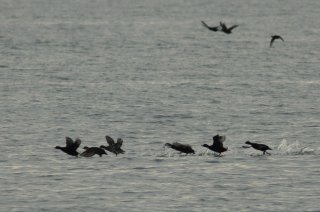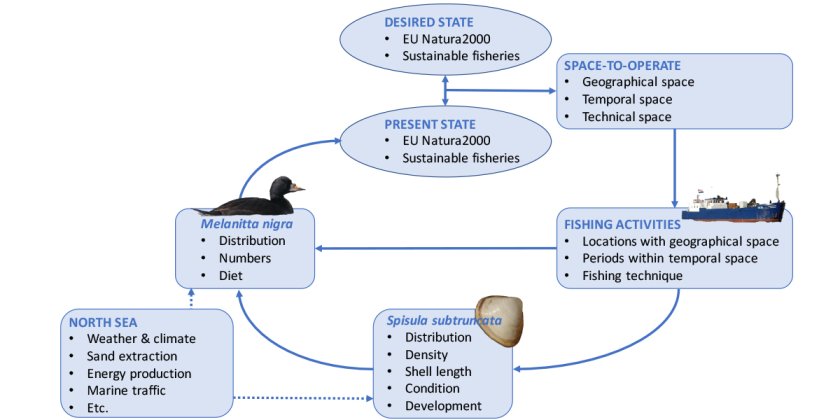
Project
EFMZV - Space for Birds and Fishermen
Operational perspective for sustainable fisheries on Spisula subtruncata in Dutch coastal waters.
Contents
After a period of very low fishing efforts, the recent strong increase in the stock of the cut through shell (Spisula subtruncata) in Dutch coastal waters makes the harvest of this bivalve species attractive again. However, the government is reluctant to grant fishing permits because of the risk of overfishing. In particular, negative consequences for the food availability for the common scoter (Melanitta nigra) are feared (Fig. 1). This sea duck is a protected bird species (Natura 2000) for which the conservation objective for Dutch coastal waters is set at a carrying capacity of 68,500 overwintering individuals.
The starting point of this proposal is that more knowledge about the causes and effects of the developments in the shellfish and sea ducks provides a more precise bandwidth for the space-to-operate (and thus more operational security) for sustainable shellfish fishing. For this purpose, scientists (NIOZ, WMR) and fishermen (NVB) aim to establish a user-friendly and open-access data and information platform to support sustainable fisheries, under the watchful eye of bird conservationists (VBN).
Based on field observations (including voluntary sampling by fishermen during their normal operations following scientific protocols) and results of research (including environmental and behavioural aspects of shellfish and sea ducks), this platform provides current and unambiguous data and information about the development of the shellfish stock and the numbers of wintering sea ducks in the Dutch coastal waters. The shared facts and figures (the “present state” in Fig. 1) will then serve as a base for policy debates on the space-to-operate for sustainable Spisula fisheries.
This joint fact finding and sharing not only introduces innovative technical ICT-development but also, or in particular, creates an innovative way of cooperation (knowledge development, knowledge sharing and communication about knowledge) by fishery organizations, scientific institutes and NGOs for sustainable fisheries.

Collective adaptive approach
The approach within the project is to describe the present state as clearly and unambiguously as possible and to publish these findings via a user-friendly and openaccess Data and Information Portal, DIP. The scientific rigor of the data and information will be evaluated by peers (during symposia and as scientific publications, part of Activities 2, 3 and 4). Contents and functioning of the DIP will be annually evaluated by wider group of stakeholders, with their feedbacks being used for further improvements.
The DIP is fed continuously with field data and model results on shellfish and sea ducks. Hereto, scientific protocols are jointly developed and tested for fishermen to gather samples (shellfish, sediments) and observational data (water quality, sea duck distribution) during their normal operations. This information is statistically analysed for patterns and developments in time and space, including fundamental and realised niches, source-sink relationships and carrying capacity for sea ducks.
The comparison between the desired state and the present state is made annually during masterclasses of the project team (NIOZ, NVB, WMR, VBN) with civil servants involved in nature conservation and fisheries. Attention is also paid to exploring the possibilities of increasing the market value of Spisula and widening the local market for sustainable seafood, such as the “Tasting Shellfish” publication that includes narratives, ecological information and recipes. Amongst other outreach events, information on the findings and progress of the project will be shared with the media during annual trips on fishing vessels, with representatives of all parties of the consortium on board.
Project overview
The project activities started on July 1, 2018 and the project will run for three years. The project is largely funded by the European Maritime and Fisheries Fund (EMFF). The fund aims to help fishermen in the transition to sustainable fishing, supports coastal communities in diversifying their economies, finances projects that create new jobs and improve quality of life along European coasts and makes it easier for applicants to access financing.